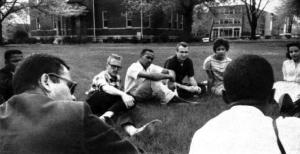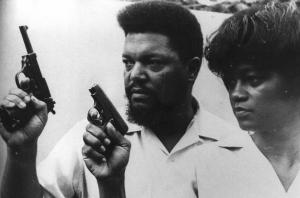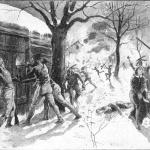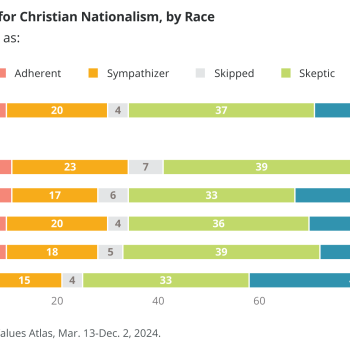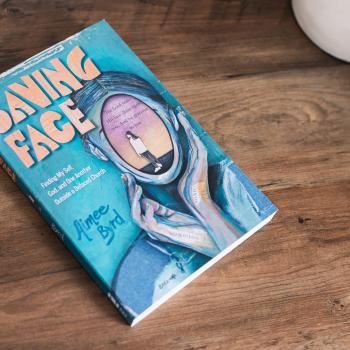During the month of April at the Anxious Bench, a number of our columnists are participating in a joint collaboration with the AACC (Asian American Christian Collaborative) to draw attention to the history of gun violence in the United States. Since the shootings in Buffalo, Laguna Woods, and Uvalde, the AACC has been a crucial Christian organization that is actively pursuing advocacy and policy efforts to address gun violence in the United States, and the Anxious Bench is proud to partner with them to raise awareness about the long and terrible history of gun violence in the United States.
I’ve known for months that this post was going to be about gun violence, part of a month-long collaboration between the Asian American Christian Collaborative and the Anxious Bench. What I didn’t know–couldn’t have known–was that a week ago Evelyn Dickhaus, 9, William Kinney, 9, Hallie Scruggs, 9, Mike Hill, 61, Katherine Koonce, 60, and Cynthia Peak, 61, would be killed in a mass shooting at the Covenant School in Nashville. The school, which goes from preschool to sixth grade, is located in the Green Hills neighborhood and affiliated with Covenant Presbyterian Church (PCA).
I know it well.
I actually worked at Covenant in 2015 while in graduate school. I’ve prayed in its gorgeous vaulted sanctuary, watched friends say wedding vows there, heard the words of Jesus repeated from the pulpit.
Like so many people, upon hearing the news, I’ve alternatively felt despondent about the proliferation of gun violence in America and enraged at the inaction and greed that allows it. But the scale feels so overwhelming, the discourse so toxic, the political scripts so repetitive. It’s a familiar, dark ritual: the beautiful faces, the sober press conferences, the manifestos, the grainy footage, the wails.
We lament, we pray, we call Congress again, we try not to think about it as we go to school each morning. But still, we–I–feel pretty helpless. How to live in a culture of death? How to love God in a nation that worships Moloch?*
*A note: For me, the language of religious studies is the only language that captures the sick ritual and deep moral crisis of this moment. As Garry Wills writes, “The gun is not a mere tool, a bit of technology, a political issue, a point of debate. It is an object of reverence.” This is evident in the AR-15 lapel pins that have replaced crosses. It is evident in the bowed heads at the solemn press conference. The repeated thoughts and prayers.This is not, not really, about politics. To accede to that language– to debate the merits of interpretations of the second amendment, say,–is to obscure the fundamental issue. This is about religion. About worship. About higher loves.
(Nashville Student Movement, SNCC Digital Gateway; https://snccdigital.org/inside-sncc/establishing-sncc/campus-affiliates/nashville-student-movement/)
I find comfort, as I so often do, in the resilience and creativity of Black Americans’ struggle for freedom and beloved community. Throughout their history in America, Black people have long faced the reality that the politics, culture, and laws were bent away from justice and peace, toward mammon and death. They were disenfranchised, outnumbered, despised, subject to wanton white supremacist terrorism. And yet, Black Americans not only preserved a sense of inner coherence and wholeness, they also developed a strategy to save themselves and transform the nation.
The presence of nonviolence in the civil rights movement has come to seem natural, obvious. Violent resistance would be inviting massacre; nonviolence, favorable media spectacles, or so the thinking goes. Perhaps, some assume, Black Americans lacked access to guns. They were unarmed by society, accidentally embodying, then, an otherworldly goodness. Nonviolence seems the only option.
It wasn’t.
Black Americans, in enslavement and after, have long resisted oppression and sought retribution for evil with violence. Even in the civil rights era, marked in our collective memory by brave children processing through Birmingham’s streets and the stoic determination of students at lunch counters receiving the insults and fists and streams of mustard, there were those who embraced a more violent approach. Some couched this in the language of self-defense, others, self-respect. But violent resistance to white supremacy was a strategy pre and post 1965, in the American North and South.
Take Robert Williams, the NAACP leader in Monroe, North Carolina. Tim Tyson writes in Radio Free Dixie that Williams reveals that “black Southerners stood prepared to defend home and family by force.” As early as 1959, the failure of the courts to deliver justice led Robert Williams to declare “we must meet violence with violence.” In 1962, he published a manifesto to that effect, Negroes with Guns. In chapters entitled “Self Defense Prevents Bloodshed,” “Self Defense Prevents a Pogrom,” and “Nonviolence Emboldens Racists,” Williams made his case. Armed defense was rational, understandable.
(Robert F. and Mabel Williams, PBS image)
Nonviolence, then, we see, was intentional, studied, deliberate choice. It was a choice even King himself made. After being thrust into prominence in the Montgomery Bus Boycott and receiving death threats, King famously applied for a concealed carry permit. He was denied. Even still he flirted with the need for guns. Historian David Garrow, in Bearing the Cross, recounts how Bayard Rustin saw a gun in King’s parsonage. When he asked about it, King invoked self-defense. Rustin countered, then and in subsequent conversations, that even the presence of a weapon was contrary to the movement they were building. (73) King was convinced, especially after a 1959 trip to India to learn satyagraha from Gandi. As James Peterson astutely observes in the Philadelphia Inquirer: King chose the Second Commandment over the Second Amendment.
Nonviolence is a moral position, “a love-centered way of thinking, speaking, acting, and engaging,” King put it in Stride Toward Freedom– one that invites “personal, cultural and societal transformation.” Theorists and practitioners like Rustin, as well as Rev. James Lawson and Rev. Glen Smiley drew on pacifistic and Quaker examples in developing the praxis on nonviolent direct action for American caste. It would be a way of protesting segregation, certainly, but would also present another way of being. As Anthony Siracusa explains in Nonviolence Before King, “For a critical cohort of activists and intellectuals, this decision to take nonviolent direct action was just that: a choice about how to be in the world.” (4) They trained scores of young people, in Atlanta and Ohio and, yes, even Nashville.
The Student Nonviolent Coordinating Committee held training exercises in which young people practiced holding love, asserting their beings, as they faced the taunts and mobs and cops. In doing so, they were willing to offer their bodies to confront the nation with itself. In meeting force with soul force, nonviolent activists embodied a moral question: would it be love or hate? Would it be “chaos or community”?
The question endures.
While there is some pragmatic logic in nonviolence–sympathy, positive media coverage, useful martyrs–it is a philosophy rooted in larger teleological frames and the hope of repentant possibilities. In rejecting the worldly logic of a good guy with a gun versus a bad guy with a gun, people insist on another way of being, call upon a deeper hope, and preview a world where the lion and the lamb lay down together.
We remember the choice of many to pursue nonviolence this of all weeks–a week in which parents lay their children in the ground in Nashville, the Christian Holy Week in which Jesus is buried. Remembering Christ, the model of nonviolence for civil rights activists, the one who was silent before his shearers, who “opened not his mouth,” and in an ultimate act of transformative hope, gave up his spirit while calling for forgiveness for enemies.
So who will it be? Jesus Christ? Or Moloch?


